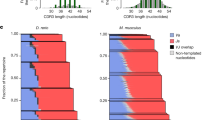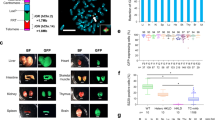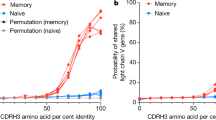Abstract
The γ-chain genes are encoded by immunoglobulin-like gene segments in germline DNA which rearrange during the somatic development of T cells to form an active gene1–7. The protein produced by these genes has not been identified and the diversity of the proteins that the genes can express has not been determined. We expect that the diversity of expressed γ-chains is produced by the same three mechanisms that produce diversity of other immunoglobulin-like genes: (1) germline variable (V) and joining (J) region repertoires; (2) somatic mutation; and (3) junctional diversity8,9. To define the contribution of each of these mechanisms to the generation of γ-chain diversity, several γ-chain complementary clones and rearranged γ-chain genes have been characterized. Most of these clones seem to encode a defective γ-chain, the variable- and constant-region portions being joined such that they would not be translated in the same reading frame. Here we report that the germline J-region diversity of the human T-cell γ-chain is very limited and that somatic mutation does not contribute to the diversity of the γ-chains encoded by the cloned segments. However, the junctional diversity of these γ-chain genes is extensive. We suggest that N sequences (template-independent sequences) have been inserted enzymatically into all of the γ-chain genes characterized.
This is a preview of subscription content, access via your institution
Access options
Subscribe to this journal
Receive 51 print issues and online access
$199.00 per year
only $3.90 per issue
Buy this article
- Purchase on Springer Link
- Instant access to full article PDF
Prices may be subject to local taxes which are calculated during checkout
Similar content being viewed by others
References
Saito, H. et al. Nature 309, 757–762 (1984).
Hayday, A. C. et al. Cell 40, 259–269 (1985).
Kranz, D. M. et al. Nature 313, 752–755 (1985).
Murre, C. et al. Nature 316, 549–552 (1985).
Lefranc, M. P. & Rabbitts, T. H. Nature 316, 464–466 (1985).
Quertermous, T. et al. Science 231, 252–255 (1986).
Lefranc, M. P., Forster, A. & Rabbitts, T. H. Nature 319, 420–422 (1986).
Tonegawa, S. Nature 302, 575–581 (1983).
Kronenberg, M., Siu, G., Hood, L. E. & Shastri, N. A. Rev. Immun. (in the press).
Maxam, A. M. & Gilbert, W. Meth. Enzym. 65, 499–560 (1980).
Dialynas, D. P. et al. Proc. natn. Acad. Sci. U.S.A. 83, 2619–2623 (1986).
Maniatis, T., Fritsch, E. F. & Sambrook, J. Molecular Cloning: A Laboratory Manual (Cold Spring Harbor Laboratory, New York, 1982).
Sakano, H., Kurosawa, Y., Weigert, M. & Tonegawa, S. Nature 290, 562–565 (1981).
Kavaler, J., Davis, M. M. & Chien, Y. Nature 310, 421–423 (1984).
Siu, G. et al. Nature 311, 344–350 (1984).
Alt, F. & Baltimore, D. Proc. natn. Acad. Sci. U.S.A. 79, 4118–4122 (1982).
Desidero, S. et al. Nature 311, 752–755 (1984).
Heilig, J. S. et al. Nature 317, 68–70 (1985).
Early, P. & Hood, L. Cell 24, 1–3 (1981).
Author information
Authors and Affiliations
Rights and permissions
About this article
Cite this article
Quertermous, T., Strauss, W., Murre, C. et al. Human T-cell γ genes contain N segments and have marked junctional variability. Nature 322, 184–187 (1986). https://doi.org/10.1038/322184a0
Received:
Accepted:
Issue Date:
DOI: https://doi.org/10.1038/322184a0
This article is cited by
-
Polymorphism ofTcrb andTcrg genes in Biozzi mice: Segregation analysis of a newTcrg haplotype with antibody responsiveness
Immunogenetics (1990)
-
T-Cell receptor and autoimmune disease
Immunologic Research (1990)
-
The adult T-cell receptor 5-chain is diverse and distinct from that of fetal thymocytes
Nature (1988)
-
T-cell antigen receptor genes and T-cell recognition
Nature (1988)
-
T-cell receptors of human suppressor cells
Nature (1987)
Comments
By submitting a comment you agree to abide by our Terms and Community Guidelines. If you find something abusive or that does not comply with our terms or guidelines please flag it as inappropriate.



